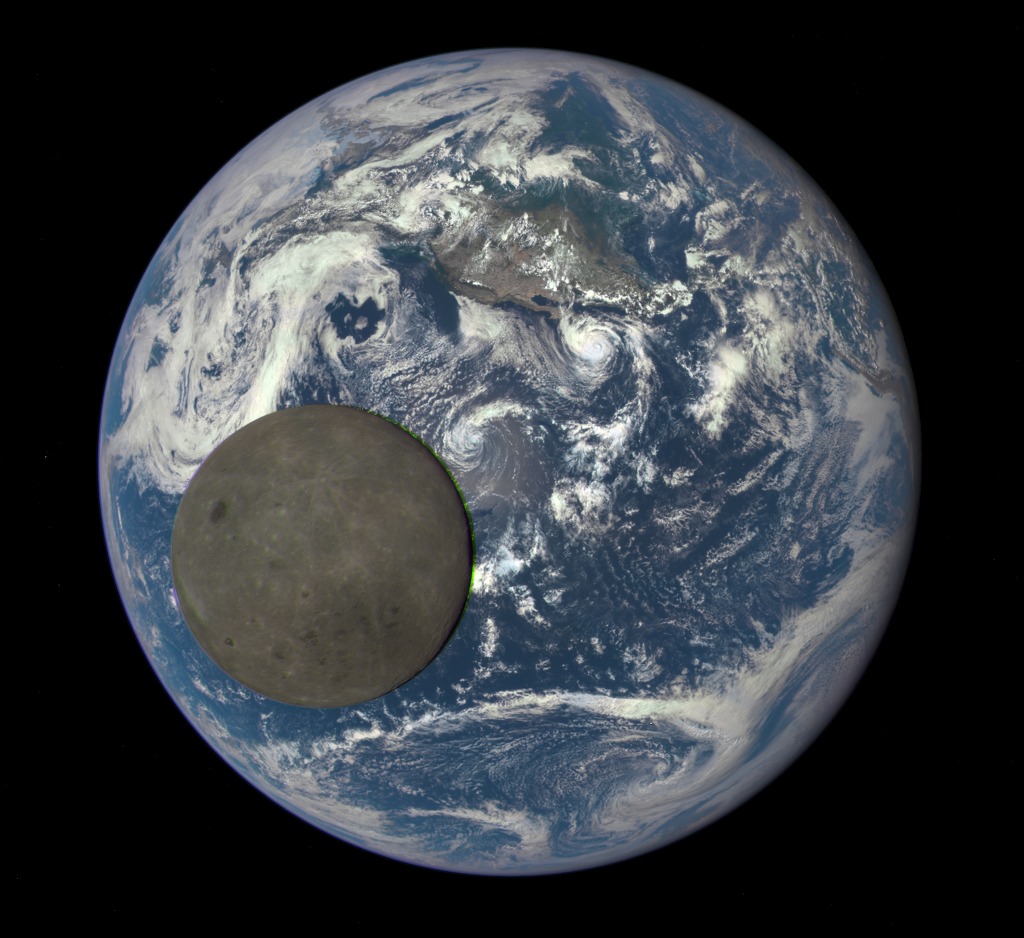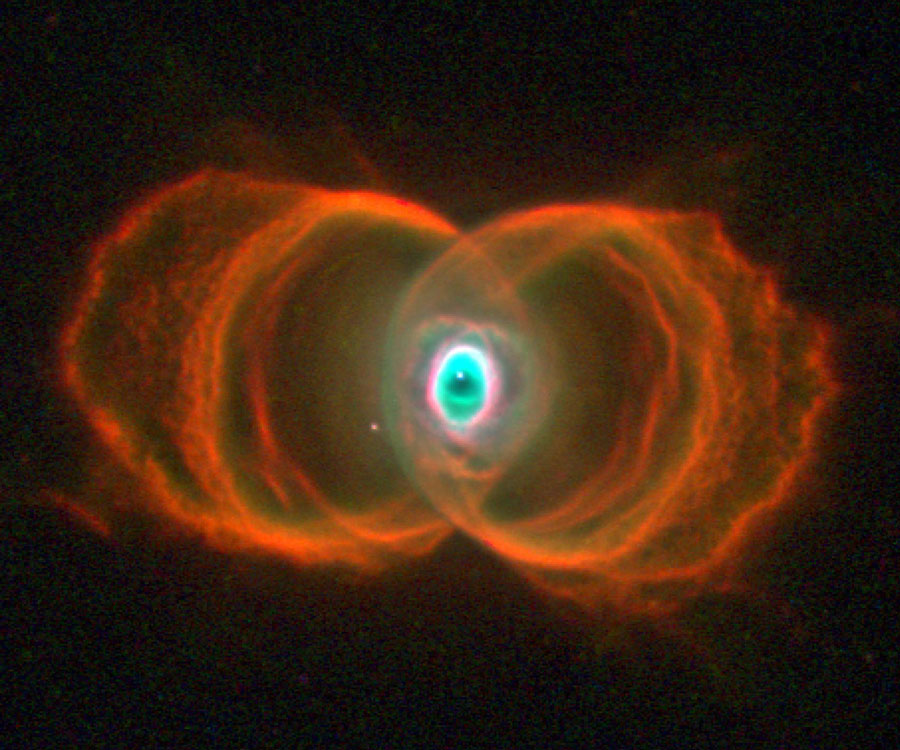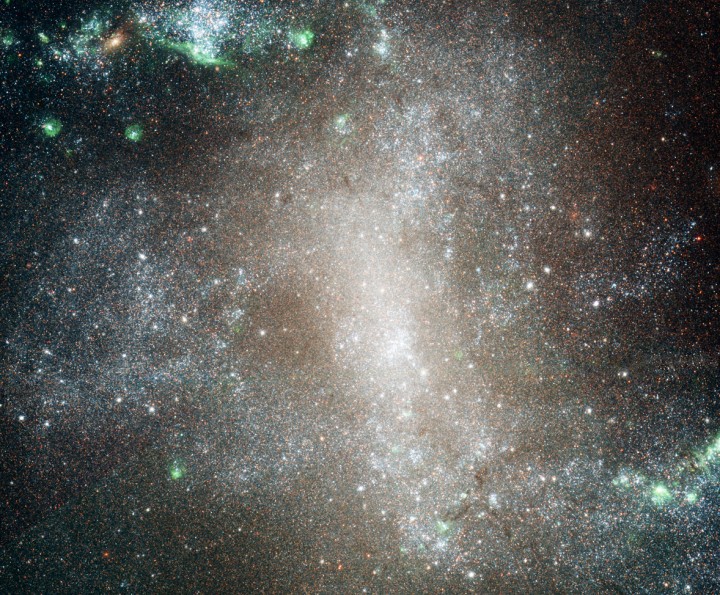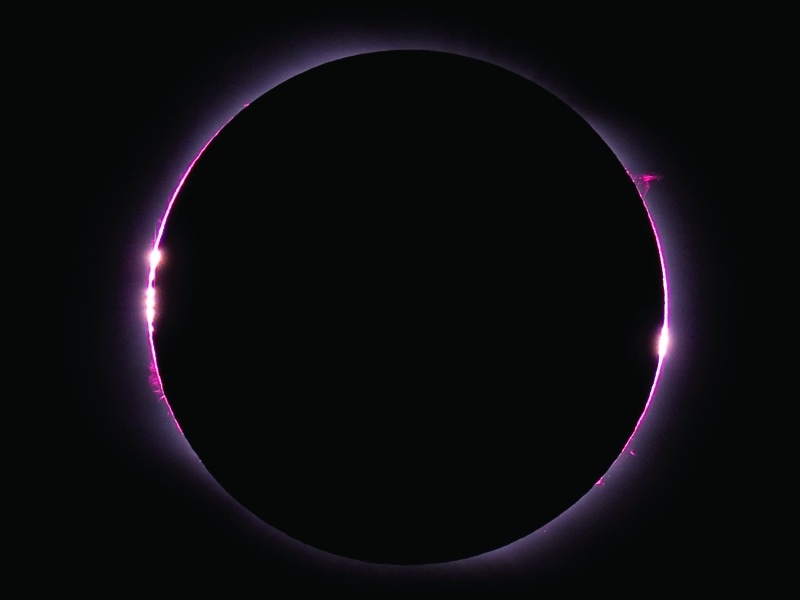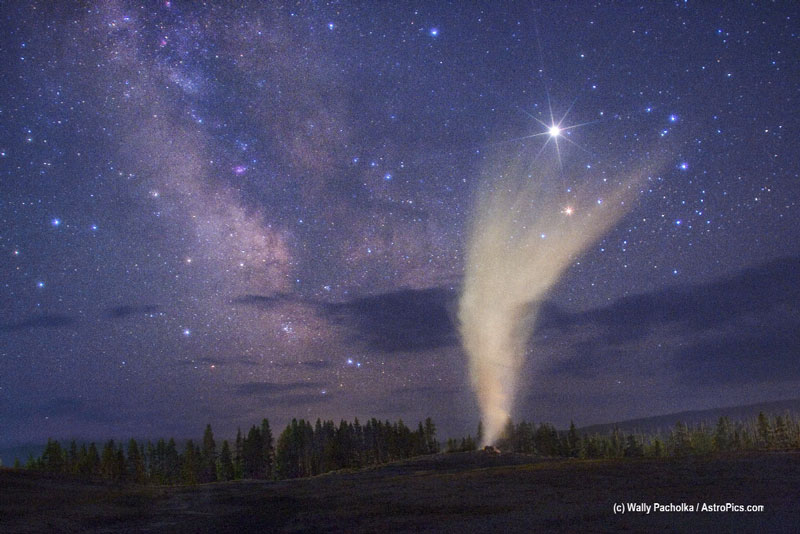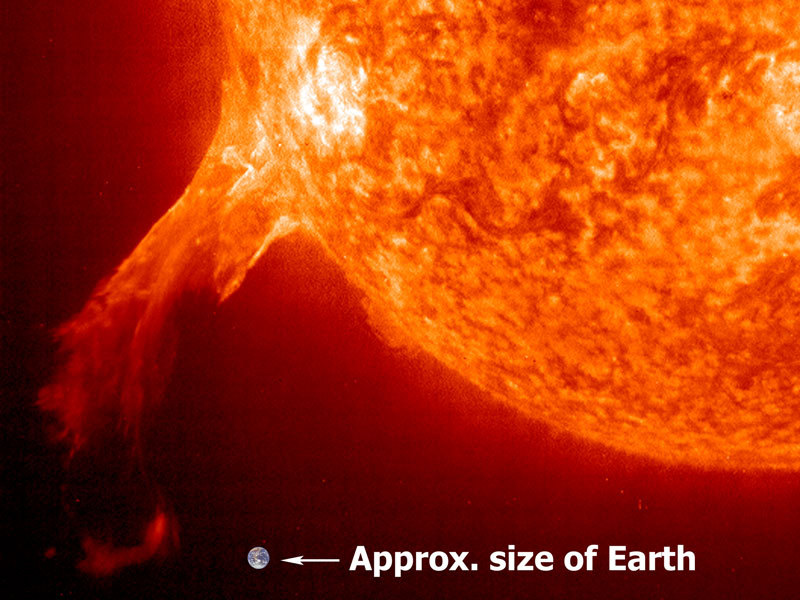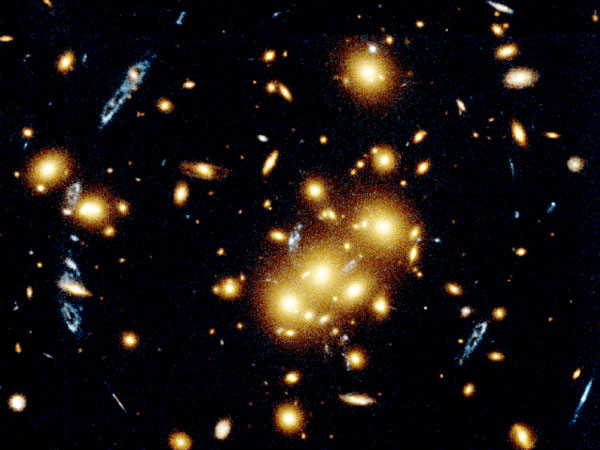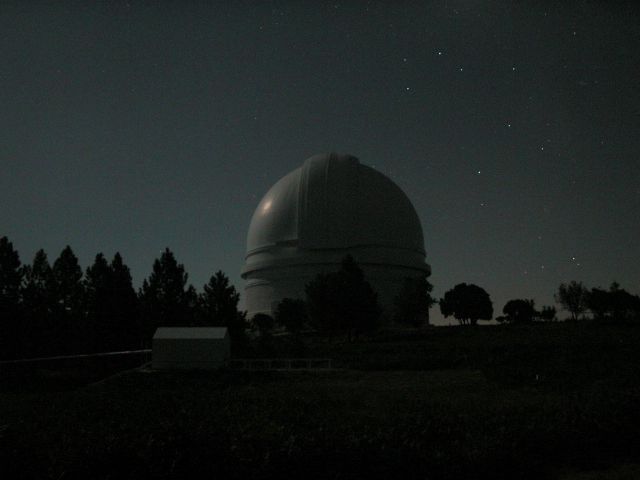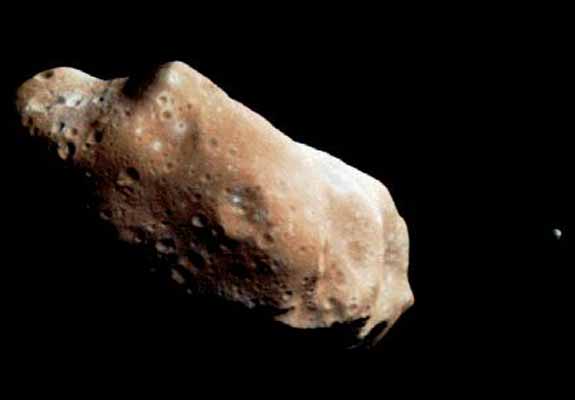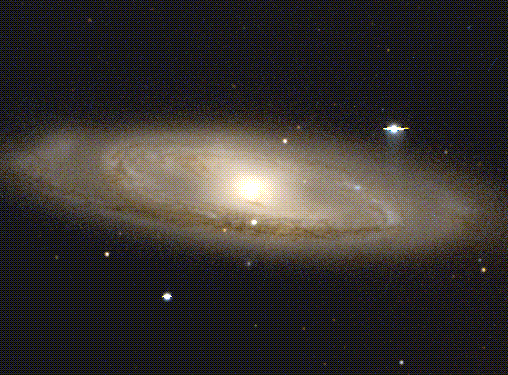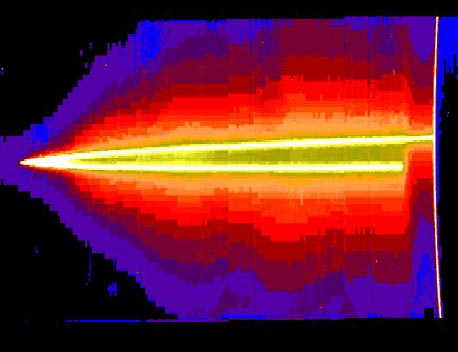| << Previous | Index | Next >> |
2015 The Moon was new on July 16. Its familiar nearside facing the surface of planet Earth was in shadow. But on that date a million miles away, the Deep Space Climate Observatory (DSCOVR) spacecraft's Earth Polychromatic Imaging Camera (EPIC) captured this view of an apparently Full Moon crossing in front of a Full Earth. In fact, seen from the spacecraft's position beyond the Moon's orbit and between Earth and Sun, the fully illuminated lunar hemisphere is the less familiar farside. Only known since the dawn of the space age, the farside is mostly devoid of dark lunar maria that sprawl across the Moon's perpetual Earth-facing hemisphere. Only the small dark spot of the farside's Mare Moscoviense (Sea of Moscow) is clear, at the upper left. Planet Earth's north pole is near 11 o'clock, with the North America visited by Hurricane Dolores near center. Slight color shifts are visible around the lunar edge, an artifact of the Moon's motion through the field caused by combining the camera's separate exposures taken in quick succession through different color filters. While monitoring the Earth and solar wind for space weather forcasts, about twice a year DSCOVR can capture similar images of Moon and Earth together as its crosses the orbital plane of the Moon.
2014 On August 3rd, the Rosetta spacecraft's narrow angle camera captured this stunning image of the nucleus of Comet 67P/Churyumov-Gerasimenko. After 10 years and 6.5 billion kilometers of travel along gravity assist trajectories looping through interplanetary space, Rosetta had approached to within 285 kilometers of its target. The curious double-lobed shape of the nucleus is revealed in amazing detail at an image resolution of 5.3 meters per pixel. About 4 kilometers across, the comet nucleus is presently just over 400 million kilometers from Earth, between the orbits of Jupiter and Mars. Now the first spacecraft to achieve a delicate orbit around a comet, Rosetta will swing to within 50 kilometers and closer in the coming weeks, identifiying candidate sites for landing its probe Philae later this year.
2013
[imghover6=http://apod.nasa.gov/apod/image/1308/au ... n_1770.jpg]http://apod.nasa.gov/apod/image/1308/au ... d_1770.jpg[/imghover6]Image Credit & Copyright: James Boardman-Woodend (Images ~ Inspired by Nature); Annotation: Judy Schmidt
2012
[imghover6=http://apod.nasa.gov/apod/image/1208/PIA15973MSL700.jpg]http://photojournal.jpl.nasa.gov/jpeg/PIA15982.jpg[/imghover6]Credit: NASA/JPL-Caltech/Mars Science Laboratory
2011 The sands of time are running out for the central star of this hourglass-shaped planetary nebula. With its nuclear fuel exhausted, this brief, spectacular, closing phase of a Sun-like star's life occurs as its outer layers are ejected - its core becoming a cooling, fading white dwarf. In 1995, astronomers used the Hubble Space Telescope (HST) to make a series of images of planetary nebulae, including the one above. Here, delicate rings of colorful glowing gas (nitrogen-red, hydrogen-green, and oxygen-blue) outline the tenuous walls of the hourglass. The unprecedented sharpness of the HST images has revealed surprising details of the nebula ejection process that are helping to resolve the outstanding mysteries of the complex shapes and symmetries of planetary nebulas.
2010 Where is the Sun when you see a rainbow? Behind you, of course. But you can see both a rainbow and the Sun (far right) side by side in this graceful panorama recorded on July 28. The cloudy sunset view covers a full 360 degrees around the horizon, composed using 20 individual images taken from an observatory on the outskirts of Potsdam, Germany. The rainbow itself is produced by sunlight internally reflected in rain drops from the direction opposite the Sun back toward the observer. As the sunlight passes through the drops, from air to water and back to air again, longer wavelengths (redder colors) are refracted or bent less than shorter wavelengths (bluer colors), separating the sunlight into the colors of the rainbow. This sharp picture captures the full, bright, primary rainbow arc as well as more subtle effects. You can see a partial, dimmer, secondary rainbow arc above and left of the primary, and faint arcs just inside the primary rainbow called supernumerary rainbows.
2009 Like grains of sand on a cosmic beach, individual stars of barred spiral galaxy NGC 1313 are resolved in this sharp composite from the Hubble Space Telescope's Advanced Camera for Surveys (ACS). The inner region of the galaxy is pictured, spanning about 10,000 light-years. Hubble's unique ability to distinguish individual stars in the 14 million light-year distant galaxy has been used to unravel the fate of star clusters whose bright young stars are spread through the disk of the galaxy as the clusters dissolve. The exploration of stars and clusters in external galaxy NGC 1313 offers clues to star formation and star cluster evolution in our own Milky Way.
2008 A train trip on the Trans-Siberian railway to Novosibirsk resulted in this stunning view along the edge of the Sun recorded during the August 1st total solar eclipse. The picture is a composite of two images taken at special moments in the eclipse sequence, corresponding to the very beginning and the very end of the total eclipse phase. Those times are known to eclipse chasers as 2nd and 3rd contact. Bright beads around the Moon's dark silhouette are rays of sunlight shining through lunar valleys at the edge of the lunar disk. But the composite view also captures solar prominences, looping structures of hot plasma suspended in magnetic fields, extending beyond the Sun's edge.
2007 You don't have to be at Yellowstone to see a sky this beautiful, but it helps. Only at Yellowstone National Park in Wyoming, USA, would you see the picturesque foreground of the famous Old Faithful Geyser erupting in front an already picturesque sky. Old Faithful Geyser, visible in the foreground, is seen propelling a stream of hot water over 30 meters in the air. This happens predictably for a few minutes about every 90 minutes. Also predictable are the brightest orbs that populate the nighttime sky, although those visible at any one time keep changing. Visible far in the background sky of this mid-July image are the plane of our Milky Way Galaxy on the left, and the bright planet Jupiter on the right. Jupiter is the brightest celestial object in the entire image. Old Faithful has been erupting at least since the late 1800s.
2006 Our Sun is still very active. In the year 2000, our Sun went though Solar Maximum, the time in its 11-year cycle where the most sunspots and explosive activities occur. Sunspots, the Solar Cycle, and solar prominences are all caused by the Sun's changing magnetic field. Pictured above is a solar prominence that erupted in 2002 July, throwing electrons and ions out into the Solar System. The above image was taken in the ultraviolet light emitted by a specific type of ionized helium, a common element on the Sun. Particularly hot areas appear in white, while relatively cool areas appear in red. Our Sun should gradually quiet down until Solar Minimum occurs, and the Sun is most quiet. No one can precisely predict when Solar Minimum will occur, although some signs indicate that it has started already!
2005 Will it be curtains for one of these auroras? A quick inspection indicates that it is curtains for both, as the designation "curtains" well categorizes the type of aurora pattern pictured. Another (informal) type is the corona. The above auroras resulted from outbursts of ionic particles from the Sun during the last week of 2001 September. A polarity change in the solar magnetic field at the Earth then triggered auroras over the next few days. The above picture was taken on 2001 October 3 as fleeting space radiation pelted the Earth's atmosphere high above the Yukon in Canada.
2004 What are those strange blue objects? Many are images of a single, unusual, beaded, blue, ring-like galaxy which just happens to line-up behind a giant cluster of galaxies. Cluster galaxies here appear yellow and -- together with the cluster's dark matter -- act as a gravitational lens. A gravitational lens can create several images of background galaxies, analogous to the many points of light one would see while looking through a wine glass at a distant street light. The distinctive shape of this background galaxy -- which is probably just forming -- has allowed astronomers to deduce that it has separate images at 4, 8, 9 and 10 o'clock, from the center of the cluster. Possibly even the blue smudge just left of center is yet another image! This spectacular photo from the Hubble Space Telescope was taken in October 1994.
2003 What's wrong with this picture? The summer night sky is clear, and moonlight illuminates the dome of the Hale 200-inch Telescope at Palomar Observatory, northeast of San Diego, California, USA. The familiar stars of the Teapot asterism in the constellation Sagittarius shine above the dome and to the right. In fact, the only thing wrong with the picture is that the observatory dome's two massive shutters are closed tight ... on a clear night. This extremely unusual situation is a precaution prompted by the presence of airborne ash and smoke from wildfires in the area on July 17 which could have damaged the historic mirror's aluminum coating. Amateur astronomer Greg Redfern notes that this year has been a particularly bad one for observatories and wildfires, with the Mt. Stromlo Australian Observatory disaster and fires also threatening telescopes on Mount Lemmon near Tucson, Arizona.
2002 What, in heaven, is that? Sometimes astronomers see things on the sky they don't immediately understand. In 1985 this happened to Arturo Gomez, and the object became known as Gomez's Hamburger for its distinctive yet familiar shape. After some investigation, the object was identified as a proto-planetary nebula, a gas cloud emitted by a Sun-like star just after its central hydrogen fuel has all been fused to helium. Gomez's Hamburger is on its way to becoming a full-fledged planetary nebula in a few thousand years. The light seen (the bun) is reflected by dust from the central star, although the star itself is obscured by a thick dust disk that runs across the middle (the patty). Gomez's Hamburger, pictured above in a recent image from the Hubble Space Telescope, is only a fraction of a light year across but located approximately 10,000 light years away towards the constellation of Sagittarius.
2001 Those up before dawn in late July in the northern hemisphere could see planets, stars, and a spacecraft in a single quick glance before starting their day. Near the eastern horizon was bright Jupiter, and not far above and to its right was the very bright Venus. Connecting the dots will point you just right of Saturn. Far in the distance but near the top right of the frame is the Pleiades star cluster. Orbiting the Earth well in the foreground, the International Space Station reflected sunlight to cause the faint line segment. In the very close foreground, the bright red and yellow lines were caused by a passing van. The above picture was taken on July 26 from Quebec, Canada. Why are bushes visible through the van? The van was present for only a few of the 25 seconds of the total exposure.
2000 A planet has been found orbiting a Sun-like star only 10 light-years away. No direct picture of the planet was taken - the planet was discovered by the gravitational wobble it created on its parent star, Epsilon Eridani. The discovery marks the closest Sun-like star yet found to house an extra-solar planet. Pictured above, the star Epsilon Eridani is visible near the belt of Orion to the unaided eye. The detected planet is thought to have a mass like Jupiter but orbit slightly closer in. The elliptical nature of the planet's orbit raises questions about whether the nearly circular orbits of planets in our own Solar System are relatively uncommon. It is unknown whether other planets exist around Epsilon Eridani.
1999 This asteroid has a moon! The robot spacecraft Galileo currently exploring the Jovian system, encountered and photographed two asteroids during its long journey to Jupiter. The second asteroid it photographed, Ida, was discovered to have a moon which appears as a small dot to the right of Ida in this picture. The tiny moon, named Dactyl, is about one mile across, while the potato shaped Ida measures about 36 miles long and 14 miles wide. Dactyl is the first moon of an asteroid ever discovered. The names Ida and Dactyl are based on characters in Greek mythology. Do other asteroids have moons?
1998 Messier 65 (M65) is a bright spiral galaxy of stars only 35 million light-years away in the constellation Leo. With very tightly wound spiral arms, a large central bulge, and well defined dust lanes, this galaxy is a member of a group of galaxies known as the Leo triplet. The faint blue smudges along the spiral arms of M65 are large clusters of bright, newly formed stars within the distant galaxy while the bright individual stars are foreground objects in our own Milky Way galaxy. North is to the left in this composite of digital pictures taken using the large 4-meter (diameter) Mayall telescope at Kitt Peak National Observatory in the southwestern United States. The horizontal stripes are digital blemishes ... but the image has been adjusted to remove the blotch created by a moth which worked its way into the camera's filter wheel.
1997 Why do small particles hover around Jupiter's rings? These particles form a previously unknown ring halo, recently discovered by the robot spacecraft Galileo currently orbiting Jupiter. Galileo obtained this image when on the far side of Jupiter - from this orientation scattered sunlight makes the halo ring visible. The amount of scattering indicates that halo particles are very small - perhaps 100 times smaller than the width of a human hair. Particles this small are believed to survive only for years, and so must somehow be replenished to Jupiter's ancient ring system. One possible explanation for this unusual halo is that electromagnetic fields around Jupiter gently push small charged particles out of the ring plane. This false color image has been artificially stretched in the vertical direction to highlight the ring halo.
1996 Today a team of NASA and Stanford scientists announced the discovery of strong circumstantial evidence that microscopic life once existed on Mars. Dr. David McKay, Dr. Everett Gibson, and Kathie Thomas-Keprta of Lockheed-Martin, all from (NASA /JSC), and Dr. Richard Zare (Stanford) have led a team that has found chemical evidence for past life on Mars - including what they interpret as possible microscopic fossil remains (tube-like structures pictured above) - in a meteorite thought to have originated on Mars. A small fraction of the many meteorites that fall to Earth from space have composition similar to the Martian surface. Many scientists believe that these meteorites are indeed Martian rocks that have been catapulted into space during a catastrophic event on Mars, such as an asteroid impact. The escaped rocks would then circle the inner Solar System, some of them falling to Earth. The meteorite containing the evidence landed on Earth 13,000 years ago, but may indicate a life-form that existed on Mars billions of years ago. The team's findings will be published in the August 16 issue of Science Magazine. Even skeptical scientists look forward to future research confirming or refuting these exciting claims.
1995 Space Shuttle Endeavour thunders off into orbit in a rare night launch. This March 1995 mission is most famous for operating the set of astronomical telescopes known as Astro-2. Astro-2's telescopes observed the universe in ultraviolet light - light so blue humans by themselves can't see it. Astro-2 measured the amount of ultraviolet light emitted by several interesting stars, galaxies, planets, and QSOs. Analysis of data from this NASA mission has yielded the first clear detection of helium created during the beginning of the universe. For more information about NASA's Space Shuttle missions, see the NASA Space Shuttle Launches page.
| << Previous | Index | Next >> |
